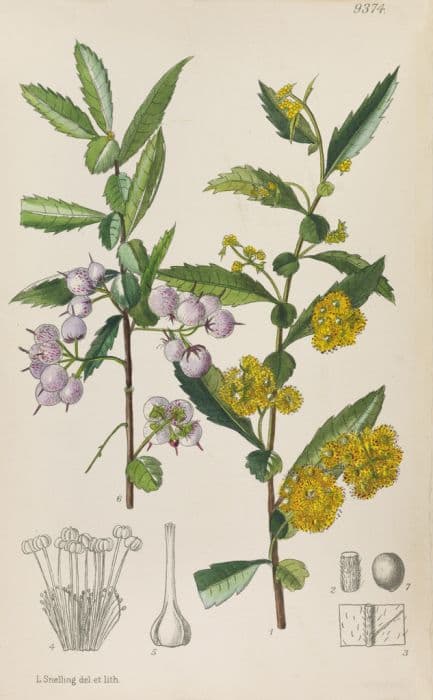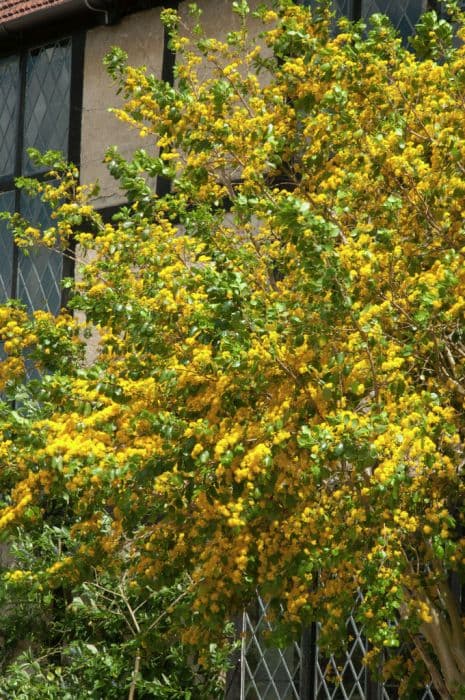Coral Bark Willow Salix alba var. vitellina 'Britzensis' (m)

ABOUT
Salix alba var. vitellina 'Britzensis', commonly known as Coral Bark Willow, is a deciduous tree known for its striking winter appearance. Its most prominent feature is the bright coral-red to orange color of its young branches, which provide a vibrant contrast to the winter landscape. As the branches mature, the color fades to a yellowish or gray hue. The bark on older parts of the tree is usually deeply furrowed and has a more muted color. The leaves of the Coral Bark Willow are slender and elongated, with finely serrated edges. They are typically green in color during the growing season and may turn yellow before falling off in autumn. The foliage arrangement is alternate, giving the tree a somewhat airy and irregular canopy. In spring, the plant develops catkins, which are cylindrical flower clusters that can add further interest to its appearance. These catkins are typically yellowish and can add a soft texture to the tree's look. Overall, the Coral Bark Willow presents a multi-season interest, with its most striking attribute being the winter coloration of its young stems, providing a stark and appealing look during colder months when most other plants have lost their leaves.
About this plant
 Names
NamesFamily
Salicaceae
Synonyms
Scarlet Willow, Coral Bark Willow, Britzensis Willow
Common names
Salix alba var. vitellina 'Britzensis', Salix alba 'Britzensis'
 Toxicity
ToxicityTo humans
The plant in question is commonly known as White Willow. Generally, White Willow is not considered toxic to humans. However, the bark of the White Willow contains salicin, which is a chemical similar to aspirin. While salicin itself is not highly toxic, if consumed in large quantities it could theoretically cause side effects similar to those of aspirin overdose, which may include nausea, vomiting, tinnitus (ringing in the ears), and in severe cases, respiratory alkalosis and metabolic acidosis. However, such cases are rare, and White Willow is often actually used in herbal medicine for its pain-relieving properties.
To pets
White Willow, when it comes to pets, poses a similar risk profile as it does to humans. Salicin can cause effects similar to aspirin toxicity. For pets, particularly cats and dogs, ingesting White Willow in large quantities could lead to gastrointestinal upset, such as vomiting and diarrhea, or more serious conditions related to aspirin toxicity, such as alterations in blood clotting, kidney damage, and central nervous system effects like lethargy or seizures in severe instances. However, cases of toxicity are generally uncommon as pets are unlikely to ingest large amounts of this plant's bark. As with any non-food plant, monitoring your pet for any signs of unusual behavior after ingestion is a prudent precaution.
 Characteristics
CharacteristicsLife cycle
Perennials
Foliage type
Deciduous
Color of leaves
Green
Height
40 feet (12 meters)
Spread
20 feet (6 meters)
Plant type
Tree
Hardiness zones
4
Native area
Europe
Benefits
 General Benefits
General Benefits- Ornamental Value: Salix alba var. vitellina 'Britzensis', commonly known as the Coral Bark Willow, provides year-round decorative interest with its brightly colored stems.
- Wildlife Habitat: It offers a habitat for wildlife, especially birds, which use the tree for nesting and as a source of food.
- Soil Erosion Control: As a willow species, it has dense root systems that are excellent for stabilizing soil and preventing erosion, particularly on riverbanks.
- Windbreak: The Coral Bark Willow can be used as a windbreak to protect more sensitive plants and reduce wind speeds on property.
- Stream Rehabilitation: Its robust root system is effective for streambank stabilization and rehabilitation projects.
- Adaptability: This tree is tolerant of a variety of soil conditions, making it a versatile choice for different landscapes.
- Fast Growth: It has a rapid growth rate, which is beneficial for creating quick shade or achieving a mature landscape in a shorter time frame.
- Improving Biodiversity: Introducing this species to an area can enhance local biodiversity, supporting a range of insect species.
 Medical Properties
Medical Properties- Analgesic: Contains salicin, which the body metabolizes into salicylic acid, the precursor to aspirin, and is used to help relieve pain.
- Anti-inflammatory: The salicin in Salix alba also has anti-inflammatory properties, which can help reduce inflammation and swelling.
- Fever reducer: Historically used to treat fevers due to its ability to help lower body temperature.
- Antirheumatic: Traditionally used to help treat symptoms of rheumatic conditions such as arthritis.
 Air-purifying Qualities
Air-purifying QualitiesThis plant is not specifically known for air purifying qualities.
 Other Uses
Other Uses- Livestock Fodder: The leaves and twigs of the Willow can be used as fodder for livestock, particularly in regions where other fodder may be scarce in the late winter or early spring.
- Art and Craft Material: The striking yellow to orange stems of the Coral Willow are used by artists and craftspeople for weaving baskets, creating sculptures, and in decorative arrangements.
- Erosion Control: Willows are often planted along stream banks for their ability to stabilize soil and prevent erosion with their fibrous root systems.
- Windbreaks: The dense growth habit makes Coral Willow suitable for use in windbreaks or privacy screens.
- Environmental Remediation: Willows are sometimes used in phytoremediation projects to absorb heavy metals and other contaminants from the soil or water.
- Fishing Nets: The flexible branches of the Willow can be used to create the structure of traditional fishing nets.
- Acoustic Instruments: The wood of the Coral Willow is sometimes utilized in the construction of certain musical instruments due to its acoustic properties.
- Insect Hotels: Willow branches can be included in 'insect hotels' or 'bug houses' as they provide natural nooks and crannies for beneficial insects to nest and overwinter.
- Tannin Extraction: Willow bark contains tannins that can be extracted and used in the tanning of leathers.
- Traditional Games: Willows have been historically used for making whistles and other traditional toys, such as pop guns.
Interesting Facts
 Feng Shui
Feng ShuiThe White Willow is not used in Feng Shui practice.
 Zodiac Sign Compitability
Zodiac Sign CompitabilityThe White Willow is not used in astrology practice.
 Plant Symbolism
Plant Symbolism- Flexibility and Resilience: The Salix alba var. vitellina 'Britzensis', commonly known as the 'Golden Willow,' is famous for its pliant branches that bend without breaking. This symbolizes the ability to adapt to life's challenges without losing strength.
- Healing: Willows have been associated with healing due to their medicinal properties, including the bark of the Golden Willow, which contains salicin, a compound similar to aspirin.
- Grief and Mourning: In many cultures, willows are considered symbols of mourning due to their drooping branches, suggesting the shedding of tears, making them a poignant emblem during times of sorrow.
- Freedom: The wind sweeping through the flexible branches of the Golden Willow voice a sense of freedom and the free flow of emotions, thoughts, and spirit.
- Intuition and Vision: Mystical traditions often associate willows with deep intuition and inner vision, suggesting an alignment with psychic abilities and dreams.
- Renewal and Growth: As a tree that thrives near water and grows rapidly, the Golden Willow represents renewal and the promise of new growth, much like the onset of spring.
 Water
WaterThe golden willow (Salix alba var. vitellina 'Britzensis') prefers consistently moist soil and should be watered deeply once a week, providing about 1.5 to 2.5 gallons per watering, depending on the weather conditions. During hot or dry periods, the golden willow may require additional water, possibly needing watering twice a week. Over the winter, watering can be reduced. It's important to avoid letting the soil dry out completely, particularly for young trees, as they establish their root systems.
 Light
LightThe golden willow thrives best in full sun, meaning it should receive at least 6 hours of direct sunlight daily. Planting the golden willow in an unobstructed area where it won't be shaded by buildings or other trees is ideal for its light requirements.
 Temperature
TemperatureGolden willows are quite hardy and can tolerate a range of temperatures, enduring minimum temperatures down to about -20 to -30 degrees Fahrenheit. The ideal temperature range for the golden willows lies between 65 to 75 degrees Fahrenheit during their growing season. They are adaptable to various climatic conditions but do best in temperate climates.
 Pruning
PruningPrune golden willows in late winter or early spring, before the onset of new growth, to maintain their shape and remove any damaged or diseased branches. Pruning encourages the production of new shoots, which display the tree's characteristic golden bark. It is typically done annually, but shaping and removal of dead wood can be done as needed throughout the year.
 Cleaning
CleaningAs needed
 Soil
SoilCoral Bark Willow thrives in consistently moist, well-draining soil rich in organic matter, with a pH range of 5.5 to 8. The best soil mix is one that combines loam, peat, and sand to enhance drainage and fertility.
 Repotting
RepottingCoral Bark Willow, being a large shrub or tree, is not typically repotted; instead, it is planted directly in the ground where it can spread its root system.
 Humidity & Misting
Humidity & MistingCoral Bark Willow requires high humidity conditions; being a willow species, it is well-suited for moist environments near water bodies or in areas with naturally high humidity.
 Suitable locations
Suitable locationsIndoor
It's infeasible to grow Coral Bark Willow inside; they're large and prefer outdoors.
Outdoor
Plant in moist soil, full sun to partial shade, and give ample room to grow.
Hardiness zone
2-8 USDA
 Life cycle
Life cycleThe Salix alba var. vitellina 'Britzensis' (m), more commonly known as the Scarlet Willow, begins its life cycle as seeds that are dispersed by wind or water. Upon finding a suitable moist soil, the seeds germinate and grow into young saplings, with their distinctive red-orange branches becoming apparent as they mature. Scarlet Willow saplings progress rapidly in growth due to their preference for wet environments and can reach full maturity within a few years. As adult trees, they produce catkins in early spring before the leaves emerge, with male trees generating pollen that is spread by the wind to fertilize female flowers. After pollination, female trees develop capsules which release numerous tiny seeds to complete the cycle. The Scarlet Willow has a lifespan that may extend several decades, during which time it will undergo continuous seasonal cycles of growth, flowering, and dormancy.
 Propogation
PropogationPropogation time
Late winter
The most popular method of propagating Salix alba var. vitellina 'Britzensis', commonly known as Coral Bark Willow, is through hardwood cuttings. This is typically done in late fall to winter when the plant is dormant. A cutting of about 6 to 9 inches (15 to 23 centimeters) is taken from a healthy, mature branch. The bottom cut should be made just below a bud, and the top cut just above a bud to maximize potential growth. The cutting is then inserted into a well-draining soil mix with the bottom two-thirds buried in the soil, keeping it moist until roots develop and new growth appears, which indicates successful rooting. This simple and efficient method is widely used due to the high success rate and the ability to reproduce true-to-type plants that retain the characteristics of the parent plant.









